|
FAQs about Marine Snail
Identification 30
Related Articles: Gastropods, Sea Slugs, Mollusks, Abalone,
Related FAQs: Snail ID
1, Snail ID 2, Snail ID 3, Snail
ID 4, Snail ID 5, Snail ID 6, Snail
ID 7, Snail ID 8, Snail ID 9, Snail ID
10, Snail ID 11, Snail ID 12, Snail
ID 13, Snail ID 14, Snail ID 15, Snail ID
16, Snail ID 17, Snail ID 18, Snail ID
19, Snail ID 20, Snail ID 21, Snail
ID 22, Snail ID 23, Snail ID 24, Snail
ID 25, Snail ID 26, Snail ID
27, Snail ID 28,
Snail ID 29,
& Marine Snails
1, Marine Snails
2, Marine Snails 3,
Invertebrate ID, Snail Behavior, Snail Selection, Snail Compatibility, Snail Systems, Snail Feeding, Snail Disease, Snail Reproduction, Mollusks, Sea
Slugs, Abalone,
|
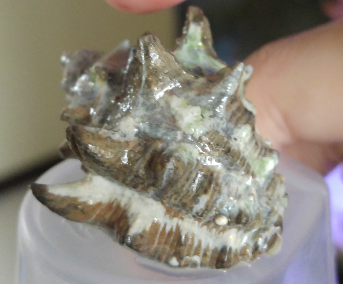
|
|
Snail Identification 2/5/19
Hi team,
Thanks for all the great work you do, I have learnt a lot from your site!
I noticed this white snail (see attached) about a month ago on my live rock and
it has grown considerably quickly since. I have looked online everywhere and
believe it may be a predatory whelk but I’m not too sure. Do you have any
thoughts on what this snail may be?
Many thanks,
Callum.
<Please crop, re-size your images to hundreds of Kbytes, and re-send.>
Re: Snail Identification 2/5/19
My apologies, I hope this image is clear enough / meets the size restrictions
(362kBytes).
Thanks
Callum
<Mmm; have you gone through the WWM SW snail ID FAQs?
Please do:
http://www.wetwebmedia.com/snailidfaqs.htm
and the linked files above. Bob Fenner>
|
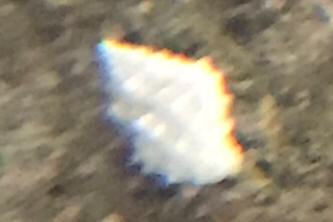 |
|
Fish eating snails 1/31/19
Good evening,
I was hoping you could help me identify a couple of different snails that I have
in my tank. I thought they were Nassarius snails and I still think the 1 is but
not sure of the other.
<The upper right one does look like a Nassarius species, the lower left, darker
one, perhaps a Cerithid>
I have attached a close up of what I believe to be 2 similar but different
snails. I know Nassarius snails will watch left over food but what concerns me
is this morning I found about 8 or so chewing on the fins of a lionfish that was
living but not dead.
<Mmmm; these snails didn't catch, kill the Lion>
I know they will consume a dead fish but I did not think they would attack one
that was living. The lionfish has since died not sure if it was already dying or
because of damage from the snails.
<The former; assuredly>
There are currently no fish and the tank will house shrimp gobies Dartfish and
fairy wrasses that build a cocoon at night. should I be worried that they would
go after a wrasse that was sleeping at night?
<I don't think so, no>
Thank Jason
<Thank you for sharing. Bob Fenner>
|
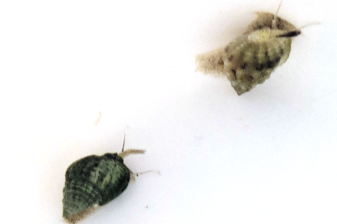 |
|
Id hitchhiking snail please 7/29/18
Hi Crew!
<Dani>
I found this very tiny snail on a liverock, it’s maybe 3mm long...could you
please help ID? Thank you as always! I hope you have a nice day.
Dani ��
<Is this a Cerith/id? Bob Fenner>
|
.jpeg) |
|
Re: Stomatella? Hitchhiker ID on Ninja Star snail
7/7/18
Hello! Hmm, I’m not quite sure this is Stomatella anymore. It has not moved off
the shell of the ninja star. Typically Stomatella I have encountered hide during
the day. Here’s another pic, any ideas?
<In this sharper/closer image, looks like a snail of the Chilodontidae family,
hope this helps. Wilberth. >
|
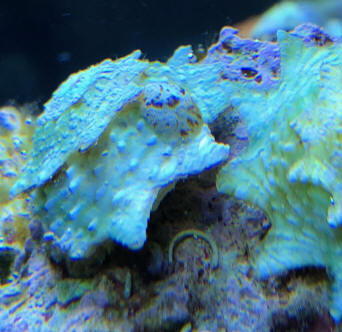 Mmm (RMF)
Mmm (RMF) |
|
Stomatella or Scutus? 11/21/17
Hello wet web crew,
<Hey KL!>
I have looked over your site and read all your limpet and snail ID threads.
My main tank is 200 gallons with 75 refugium. Currently it only has crustaceans
and soft corals in it. Mainly mushrooms and a toadstool.
I found this critter in my tank tonight and wondering what it is.
Looks like a snail but only a small shell. Is it a snail or a limpet?
What species?
<Yikes... due to striations on the shell, and that it isn't white... will guess
a Stomatellid; but... could be either>
It's about 1 3/4 inch to 2 inches.
<The shell? Most Scutus top out at 12.5 mm>
Is it friend or foe?
<Friend; purposeful algae scraper>
I'm wondering if it felt safe to come out because there are no fish currently in
the tank.
<Likely arose from your live rock; common>
It moves pretty fast for a snail. I also have video if you want me to send it.
It's shell seems frilled or scalloped along the edges and I can't really tell if
its black or a translucent shell.
<Good points. Stomatellids typically have a mantle "tail" and are not
emarginated>
Thank you for any help you can offer.
KL
<I'd keep it. Cheers, Bob Fenner>
|
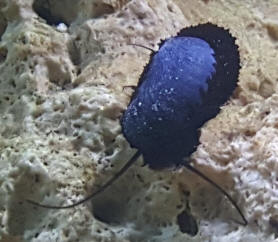 |
|
Critter ID 10/25/27
Hi there, I've got a funny little dude on one of my corals. I've asked every
reefing group I can find and no one has an idea. It started off between these
two heads of hammer coral and looked like a Chiton at first--it's a series of
armored plates. Then it sort of curved as you can see here in the photo and it's
growing fast. There are three of them now.
It is very, very hard--harder than the coral stalk and absolutely nothing budges
it, even trying to slide a razor blade under the edge hasn't been successful.
The picture below shows it just opened its 'mouth' end which is usually shut
tight. Any ideas what it could be? I'd hate to kill it if it's a reef safe
critter. Thank you!!!
<Mmm; can't quite make out in your pix, but would have guessed at first glance
that these were Chitons as you mention, and with the clue that they can't be
removed with a razor blade either limpets of some sort or, my final guess (for
now) that these are a species of calcareous tube-building worm or snail. I would
leave them here.
Thank you for sharing. Bob Fenner>
|

 |
|
What's the verdict? Snail ID
4/11/17
Hi WWM Crew,
<Eddie>
Can you please help me with a snail identification?
<Mmm; I think so. Is this a banded tulip snail?>
I’ve been seeing this hitchhiker every now and then since I put my new live
rock in my tank last month. The tank is a 75 gallon with 30 gallon sump that
will be a FOWLR for now and eventually morph into a reef with easier to care
for corals (except I wound up with a hitchhiking Kenya tree coral so I guess
I’m there already). Anyway, I’ve only seen this guy four or five times in
the last month. He hides really well. I’ve looked through the snail ID FAQs,
and seen several pictures that look like him. But sometimes the pictures are
identified as harmful, and sometimes they are identified as something else
that is not harmful.
<Is predatory if a tulip>
In short, I’m stumped on how to tell the difference. I’ve included three
pictures, including one of his under side. As you can see from the pictures
he is fat in the middle and conical in the front and rear. He has a stripped
“trunk” that retracts in and out. He uses it to poke around the sand/live
rock as he goes. His shell is about ½ inch long. What’s the verdict—harmful,
helpful, neutral?
<Unfortunately, harmful>
As always, thank you so much for your help. I really appreciate your always
being there for us.
Eddie
<You're welcome. Bob Fenner>
|
.JPG) .JPG) |
|
Mystery hitchhikers on my frogspawn
2/10/17
Hello WWM crew!
<Kevin>
I was referred here from Bayou Reef keepers by Jordan Stari.
<Ahh! Hi to Jordan. Hope to catch up with him at this year's MACNA there>
He recommended that I post this query specifically directed toward Lynn Z
since she’s the invert expert. I have a mystery beastie on the base of two
of my branching frogspawn heads. When they first showed up, they were so
small I could barely tell they were something other than part of the coral.
Then I started noticing they had kind of a corkscrew antennae or
some other protrusion. I thought they might be some kind of
Nudibranch, but even with a magnifying glass, it was difficult to pick out
any distinguishing characteristics. I searched every site and message board
I could find to no avail. They are right at the boundary between the soft
tissue and the skeleton of each head and seem to retract into the soft
tissue if I shine a light on them for more than a few seconds. When I got
home from work today, one of them had come out far enough that it was ~1/2 –
3/4” long. I took some pictures, but only one of them is small enough in
file size to comply with WWM picture requirements and it is hard to see
anything on that one. I have attached it as a first look. If it’s okay, I
would like to post the best quality picture that shows it pretty well.
Please let me know if that is ok.
<Yes; though; I don't see what you're referring to. Lynn?>
I have had these corals for about two months and they have grown probably
2-3 times the size they were when I got
them in that time. Two of the heads have begun to split. Until about 4 days
ago, all seemed to be well. All of the corals in the tank have been given a
10 minute CoralRx Pro dip before being placed in the tank. I’m thinking that
since they emerged from within the soft tissue, maybe they were there from
the beginning and survived the dip.
In the pic, the dark vertical shape on the left is the branch of the
skeleton. The offending beastie is the whitish thing running parallel to the
branch (it is roughly ½-3/4” in length). As I said, I have better pics, but
did not want to run afoul of the posting rules.
<Do post elsewhere on the Net and send along links please>
Please let me know if you know what this is, whether I should worry about
it, and how I can get rid of it if necessary.
<Like grading school papers, "When in doubt, count it out", I'd vacuum,
remove this>
Thanks in advance for the help!
Kevin Drane
<Have sent on to LynnZ for her input. Bob Fenner>
|
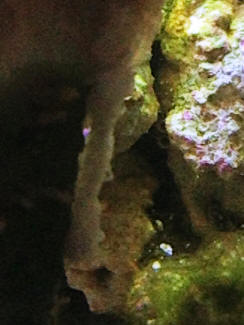
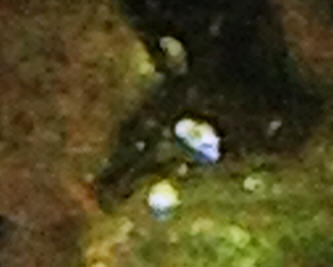 crop...
crop...
|
Re: Mystery hitchhikers on my frogspawn - 2/11/2017
Thanks for the quick response. I have a couple of pics posted on the Bayou
Reefkeeping forum. Here's a link:
Euphyllia eating Nudis?
<http://www.bayoureefkeeping.com/forums/topic/16109-euphyllia-eating-nudis/#comment-191958>
<Mmm; the little white bits right? I don't see rhinophores, gills on these...
Look more like Scutus... a snail on what little I make out... white shells
(could be overgrown), and black feet... No way for you to remove, shoot and send
a better close up pic?>
It seems to be hiding within the soft tissue of the coral because there are
times when you can't see it at all and then it just appears. Thanks again for
the help!
<The better pic please. Bob Fenner>
|
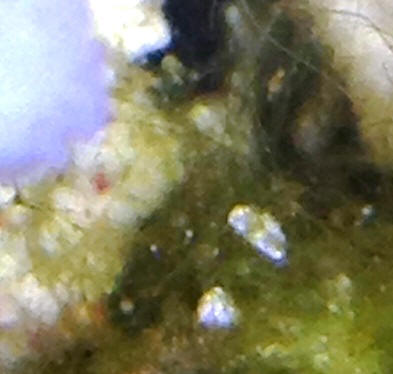 |
|
Re: Mystery hitchhikers on my frogspawn - 2/11/2017
Actually, the long white thing that is extending down from the base of the soft
tissue is one organism. The white bits are part of it.
<Don't see it mate>
There is no shell and it's all white. While it was extended out like that last
night, I tried to suck it out with a turkey baster and it held fast. I then
tried grab it with some tweezers and it still wouldn't come loose. It ended up
breaking in two. The part that was still attached retracted up into the coral's
soft tissue and I haven't seen it since. The part that broke off
kind of fell apart and the pieces were very small helical bits maybe 2-3 mm
long. My fire fish ate ended up eating the pieces. Now I'm worried that it is
going to die inside the soft tissue and as it rots will poison the coral. I'm
debating whether I want to break the heads free from the rock and dipping them
with Bayer.
<Have you considered fragging this colony? I might. B>
Re: Mystery hitchhikers on my frogspawn - 2/11/2017
Thanks for the quick response.
<<Hi Kevin and Bob. Sorry I’m a late arrival on this topic!>>
I have a couple of pics posted on the Bayou Reefkeeping forum. Here's a link:
Euphyllia eating Nudis?
http://www.bayoureefkeeping.com/forums/topic/16109-euphyllia-eating-nudis/#comment-191958
<Mmm; the little white bits right? I don't see rhinophores, gills on these...
Look more like Scutus... a snail on what little I make out...white shells (could
be overgrown), and black feet... No way for you to remove, shoot and send a
better close up pic?>
<<Unfortunately, I can’t see enough detail in the photos to determine exactly
what the subject is either. Offhand, it looks like a typical looping mass of
Cerith snail eggs - I’ve seen these before on Euphyllids. Please see the
following link for an example (bear in mind that these looping masses can be
variably arranged): http://www.nano-reef.com/topic/270550-whats-on-my-frogspawn/
. Do you have any of these snails in your system? If so, and this is an egg
mass, the multitude of loops should start breaking up and detaching within a few
days.>>
It seems to be hiding within the soft tissue of the coral because there are
times when you can't see it at all and then it just appears.
<<If this is an egg mass, perhaps it’s acting as an irritant? Honestly, I’m not
a coral expert so I’m not sure if it’s possible for the soft tissue on a
Euphyllids stalk to react by trying to alternately envelop then repel an
irritant.>>
Thanks again for the help!
<The better pic please. Bob Fenner>
<<You’re very welcome. I just wish I could have given you a concrete answer.
Ditto what Bob said regarding a photo (if possible!). Take care, Lynn Zurik>>
<Thank you Lynn. B>
Re: Mystery hitchhikers on my frogspawn: Mesenterial Filaments -
2/11/2017
<Greetings, Kevin>
I do not have any Cerith snails
<There goes that theory! On the plus-side, I believe I have an answer for you.>
and I've never seen snail eggs move around like this.
<No, any movement would have to have been caused by something else: water
current, hatching individuals, instability/movement of whatever the mass was
deposited upon, or perhaps a critter of some sort wriggling about inside the
mass.>
Unfortunately, I can't get another picture because after I tried to pull
it off, it retracted back up into the soft tissue of the coral.
<Yep, this is normal (see below).>
There is no question in my mind that it is some kind of separate organism. I
have posted another picture to the forum- this time with annotation.
<Yes, I see – thanks. After thinking about this a bit more this morning, I
started wondering if what we were seeing was simply part of the coral itself,
and that was the ticket. All those loopy structures (that look like guts) did
indeed come from inside the coral. They’re mesenterial filaments
that, thanks to stinging cells/nematocysts, are used to capture/digest, as well
as fight off any threat/intrusion into a coral’s “space”. It could be that the
coral detected a threat (physical or chemical), and deployed the filaments. I
see a small collection of vermetid gastropods to the left of the filaments that
may be at least part of the issue. Vermetids send out sticky strands to catch
food particles that drift by. Those strands could be contacting the coral’s soft
tissue and irritating it. I ran across a photo at WWM that looks very similar:
http://www.wetwebmedia.com/carydisf7.htm . Please see the query at
the bottom of the page titled “Worm infestation… no -12/28/2007”, as well as a
WWM search for mesenterial filaments, Vermetids.>
I appreciate the time you have spent trying to help me.
<No problem, I hope this helps. By the way, if you decide to get rid of the
Vermetids, you can do so my either breaking them off with tweezers at the base
(do not use bare hands – the tubes are brittle and very sharp!), or seal the
tube openings with some gel-type Cyano glue.>
Hopefully the new picture will help you see it better.
<I think we’re good to go! Take care, Lynn Zurik>
Thank you Lynn. B <Always a pleasure, Bob!>
Follow-up Re: Mystery hitchhikers on my frogspawn: Mesenterial Filaments -
2/11/2017
Awesome! Thanks for the diagnosis.
<You are most welcome.>
Jordan was right that you know your stuff.
<Well, we all learned something this time! All I knew was that things weren’t
adding up, critter-wise, so I followed a hunch and it paid off.>
You just saved the coral from the trauma of being broken off the rock and dipped
again.
<Good>
I just knew it was some kind of parasite.
<I can certainly understand why.>
Unfortunately, in my haste to keep a parasite from harming my coral, I tore some
of its mesentery trying to remove it. Hopefully it recovers!
<I would think so.>
It all makes perfect sense now that I put all the pieces together. They had
(very small) Vermetids on them when I bought them as frags. The coral and the
Vermetids have both grown considerably since I got them.
<Yay, regarding the coral! As for the Vermetids, they thrive/multiply in high
nutrient conditions so do keep an eye on this. Same goes for what appears to be
some Spionid or Chaetopterid worms to the right of the mesenterial filaments. In
silhouette, you can see a number of paired feeding tentacles (“palps”). Although
not visible in the photo, these palps extend from hardened mucus tubes covered
with sand grains, bits of substrate, and/or shell. These worms are typically
harmless/beneficial particulate feeders/detritivores but when numerous can
irritate corals, particularly Zoanthids.>
In the last couple weeks, the coral has not been extending as much as it had
been. Now I realize it was due to the Vermetids growing as much as they have. I
will try scraping them off now that I know they are causing irritation.
<Good idea. Just be careful. You do not want to get a nasty infection after
cutting yourself on those sharp little shells!>
Thanks again!
<It was a pleasure! Take care, Lynn Zurik>
|
|
|
Marine slug question
1/25/17
Hey I am wondering if you can help me identity a small yellow slug I found in my
tank there are lots of them and how I may be able to contain them.
Sent from my iPhone
<Can you crop, optimize and re-send, or make better pix... of a total of a few
hundred Kbyte size? Bob Fenner>
Re: Marine slug question
1/25/17
Sorry I'm not sure I understand why you mean. Just a clearer picture or more
zoomed as well.
<Bob's on his travels to the tropics, visiting our underwater pals. But that
means viewing large image files is a chore when he's basically stuck with
Internet access marginally better than dial-up. If you can help him out by
resizing images so they're no bigger than, say, 500 kH in size, that's great.
Online tools such as this one are useful if you don't have
image editing software to hand...
http://www.picresize.com
Cheers, Neale.>
Re: Marine slug question 1/26/17
Sent from my iPhone
<? May be a Tylodina sp. as juv.s. B>
|
 |
|
Re: Marine slug question 1/28/17
Is this a parasite?
<? Nope>
If yes do you have any suggestions as how to rid them.
<See WWM re such Gastropod Compatibility. The FAQs mate. B>
Thank you very much I am truly grateful!!!
|
|
Murex snail confirmation 12/11/16
Hi,
Is this a murex?
<Appears to be to me>
Fits the description of knobs however appears to be much shorter than what
pics are showing.
<Can be larger when specimens are young, small>
Regards,
Edwin
<Search WWM re Murex/Muricid Identification. Bob Fenner>
|
 |
|
|

